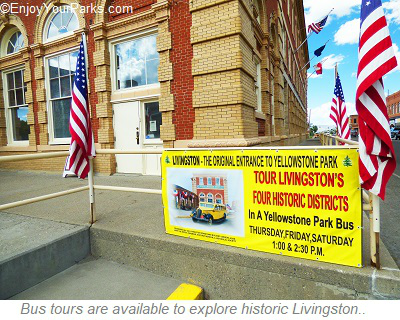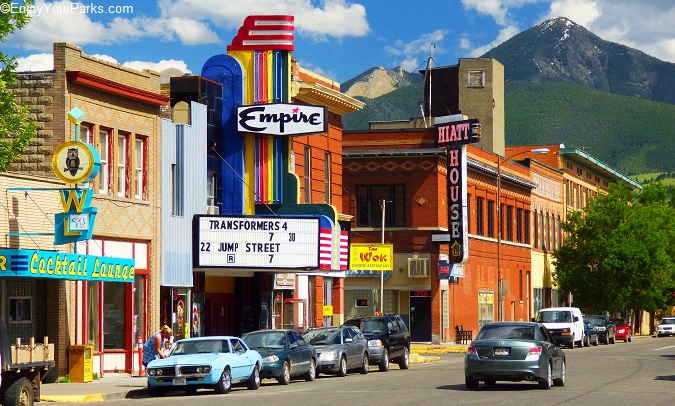Livingston Montana Area

Livingston Montana
Livingston Montana Area

Livingston Montana is a classic Montana town that is located north of Yellowstone National Park along Interstate 90, between Billings and Bozeman. Livingston Montana is not only a major gateway town to Yellowstone National Park, but it is also the hub of some amazing outdoor recreation opportunities as it sits at the end of the legendary Paradise Valley and the world-famous Yellowstone River.
Surrounded by majestic peaks of the Absaroka Range and Gallatin Range to the south, and to the northeast the towering Crazy Mountain as well as the Bridger Mountain Range to the northwest, Livingston Montana is in a stunning setting on the banks of the Yellowstone River as it leaves the remarkable Paradise Valley.
Livingston Montana was made famous by the Jimmy Buffet song “Livingston Saturday Night”, but long before this song hit the airwaves, Livingston Montana has been a major tourist center and gateway for Yellowstone National Park visitors, and it’s rich history includes Old West legends such as Calamity Jane, who lived there for 20 years.

Livingston Montana was once the one and only Gateway to Yellowstone National Park, and now there are over 17 sites listed on the National Register of Historic Places, all found within 4 separate Historic Districts located in this charming Montana town.

This is the view as drivers come down Bozeman Pass on I-90 heading into Livingston Montana. These mountains are part of the majestic Absaroka Range at the mouth of Paradise Valley. Livingston rests at the base of these mountains.

A view of the Absaroka Range in Paradise Valley just west of Livingston Montana.
Located only 26 miles east of Bozeman, with Bozeman Pass sitting between these two towns, Livingston and Bozeman are intertwined economically. 50% of Livingston Montana’s work force commutes to Bozeman each day.
Even though there are only about 7,000 residents within the city limits of Livingston Montana, this small town packs a “big punch” with its museums, restaurants, shopping and ideal located at the mouth of Paradise Valley along one of the most famous blue-ribbon trout sections of the Yellowstone River... not to mention its strong connection with Yellowstone Park.
Original Gateway To Yellowstone Park
 Livingston Montana was the original entrance into Yellowstone National Park back in the day, which emerged during the construction of the Northern Pacific Railway in the late 1800s. The historic Livingston Depot that stands today was built in 1902, however there were two earlier depots at this location.
Livingston Montana was the original entrance into Yellowstone National Park back in the day, which emerged during the construction of the Northern Pacific Railway in the late 1800s. The historic Livingston Depot that stands today was built in 1902, however there were two earlier depots at this location.
The Northern Pacific Railway was the major means of people across the country coming to Yellowstone National Park, and Livingston Montana was where they left the train before taking stagecoaches and or horses along the Yellowstone River through Paradise Valley and Yankee Jim Canyon on their 54 miles trek to Gardiner Montana at the northern border of Yellowstone National Park, which was where they would enter the park.
Livingston Montana is also located at the bottom of Bozeman Pass that looms to the west, so there was a lot of railroad activity here as trains would prepare for the steep haul up to Bozeman Pass, which marked the highest point on the entire railway. So there was a lot happening in Livingston Montana during the railway heydays.

The second of three Northern Pacific Railway Livingston Depots. This photo was taken in 1894.

Built in 1902, this is the third of 3 railroad depots built in this location along the main road through Livingston. This historic depot is now home to the Livingston Depot Museum.
 The Northern Pacific Railway at one point constructed a spur railway from Livingston to Cinnabar, via Paradise Valley and Yankee Jim Canyon along the Yellowstone River in 1883. It was built by the Rocky Mountain Railroad of Montana, but was leased to the Northern Pacific Railroad to service Yellowstone Park visitors.
The Northern Pacific Railway at one point constructed a spur railway from Livingston to Cinnabar, via Paradise Valley and Yankee Jim Canyon along the Yellowstone River in 1883. It was built by the Rocky Mountain Railroad of Montana, but was leased to the Northern Pacific Railroad to service Yellowstone Park visitors.
Then in 1898, the Northern Pacific Railway purchased the railway and extended it from Cinnabar all the way to Gardiner Montana, which is the present day North Entrance to Yellowstone Park. Not only did this railway bring tourists to Yellowstone National Park, but this spur railway also served the agricultural community of Paradise Valley.
As time passed, and as the automobile became the major means of transportation into Yellowstone Park, the need for this railway decreased, and in 1981 it was abandoned.
Today: Still A Major Yellowstone Park Gateway Town
Even though the automobile is now king, and the days of the passenger railcars are no longer found here, Livingston Montana is still considered to be a major gateway town of Yellowstone National Park because you have to pass through Livingston from Interstate 90 to get to the popular North Entrance at Gardiner Montana. These two towns are forever inherently connected as they share the roadway through Paradise Valley and Yankee Jim Canyon along the Yellowstone River.

Livingston's old historic buildings truly bring a charm to this wonderful Montana town.

One of the many charming places to enjoy Downtown Livingston Montana.
Top Livingston Montana Attractions:
Livingston Depot Museum
The Historic Livingston Depot Museum, once the center of railroad activity of visitors coming to or leaving Yellowstone National Park, this historic brick building is now home to a fantastic railroad museum that is open from May through September. If you are interested in Montana and Yellowstone Park railroad history, you’ll love this wonderfully laid out museum in the heart of Livingston Montana.

Livingston Depot Museum is located in the historic 1902 Livingston Depot building.
Yellowstone Gateway Museum
 This outstanding museum lays out the colorful history of the Livingston Montana area, including one of the oldest archaeological sites in North America, to the fascinating Wild West Days which included Calamity Jane who lived in Livingston for 20 years. The Yellowstone Gateway Museum also does a remarkable job of capturing the history of Yellowstone National Park and unfolds the significance of Livingston Montana as a gateway community to the world’s oldest and most famous national park.
This outstanding museum lays out the colorful history of the Livingston Montana area, including one of the oldest archaeological sites in North America, to the fascinating Wild West Days which included Calamity Jane who lived in Livingston for 20 years. The Yellowstone Gateway Museum also does a remarkable job of capturing the history of Yellowstone National Park and unfolds the significance of Livingston Montana as a gateway community to the world’s oldest and most famous national park.
Paradise Valley and the Yellowstone River
Paradise Valley is located directly south of Livingston Montana, which is one of the most scenic byways in the entire Rockies. U.S. Highway 89 takes visitors up this stunning valley along the Yellowstone River, with the majestic Absaroka Range to the east and Gallatin Range to the west.
You’ll see plenty of drift boats with fly fishermen and women meandering down this blue-ribbon trout fishery, and there is plenty to explore once you’re in this gorgeous valley, including a historic hot springs, great hiking trails and more. As you may have already heard, the Yellowstone River, which originates at Yellowstone Lake in Yellowstone National Park, is the longest undammed river in the United States. Click Here for all the details on Paradise Valley.

This is the view as you leave Livingston and enter Paradise Valley to the immediate south.

Paradise Valley and the Yellowstone River, with the Absaroka Range dominating the skyline.
Fly Fishing Mecca
 Livingston Montana is located along one of the most famous blue-ribbon trout streams in America. The Yellowstone River runs from Yellowstone Lake in Yellowstone Park, up through Gardiner Montana, then heads north through Yankee Jim Canyon and then Paradise Valley.
Livingston Montana is located along one of the most famous blue-ribbon trout streams in America. The Yellowstone River runs from Yellowstone Lake in Yellowstone Park, up through Gardiner Montana, then heads north through Yankee Jim Canyon and then Paradise Valley.
Once the Yellowstone River reaches Livingston Montana, the river turns eastward and eventually reaches the Missouri River at the eastern border of Montana near Glendive, over 700 miles from its source at Yellowstone Lake. The stretch between Livingston and Gardiner is a legendary fishery that is world-renowned.
And because of its ideal location, Livingston has become a fly fishing mecca that was further fueled when the 1992 Robert Redford movie “A River Runs Through It” triggered a fly fishing frenzy around the planet. Several major scenes in the movie were filmed near Livingston in Paradise Valley. As the nation watched this touching movie, many folks then bought a fly rod and headed to Montana. As the popularity of fly fishing grew, so did the fly fishing tourism in and around Livingston (as well as the entire state of Montana), and it hasn’t slowed down since.
Dan Bailey’s Fly Shop
Long before the movie “A River Runs Through It”, a fly fishing icon by the name of Dan Bailey founded the legendary Dan Bailey’s Fly Shop on Park Street in Livingston Montana in 1938. This famous fly shop still resides in this location. So if you’re wanting to find out how to catch the fabled trout swimming in the longest undammed river in the United States, and to find out what flies are hot, stop by this iconic fly fishing shop in Livingston Montana

Dan Bailey's Fly Shop in Downtown Livingston is a Montana Icon.
Fly Fishing Discovery Center
The International Fly Fishing Federation established a wonderful museum in Livingston Montana that highlights the culture of fly fishing, and is a great introduction to folks interested in learning what fly fishing is all about. The Fly Fishing Discovery Center is a great place to visit and discover what fly fishing is all about!

Fly fisherman using a drift boat on the Yellowstone River in Paradise Valley near Livingston.
Historic Downtown Livingston
Livingston Montana has a charming historic downtown that includes many of the 17 sites that are listed on the National Register of Historic Places. Within these fantastic historic buildings are now restaurants, theaters, coffee shops, gift shops and clothing stores. It really is a fun treat walking through this downtown section as these wonderful historic buildings bring back the charm of the late 1800s, with the dramatic backdrop of the Absaroka Range towering to the south.

There's certainly no shortage of historic buildings lining the streets of Downtown Livingston Montana.

Inside the lobby of the Historic Murray Hotel in Livingston Montana.
Shields River Valley Scenic Drive
 Located northeast of Livingston Montana, the Shields River Valley Scenic Drive along U.S. Highway 89 is a drive through a classic Montana valley. This broad valley is lined by the Bridger Range to the west and the Crazy Mountains to the east, with the meandering Shields River running through it on its way to the Yellowstone River.
Located northeast of Livingston Montana, the Shields River Valley Scenic Drive along U.S. Highway 89 is a drive through a classic Montana valley. This broad valley is lined by the Bridger Range to the west and the Crazy Mountains to the east, with the meandering Shields River running through it on its way to the Yellowstone River.
You'll not only enjoy the views of the mountains, but there are wide open meadows with grazing cattle and horses, original ranch and farm houses and barns, and two terrific small towns (Wilsall and Clyde Park) that do not get more "Montana" that this.
You'll even drive by an original pioneer church and cemetery at Sedan. From Livingston, the most popular way to get to the Shields River Scenic Drive is to take State Highway 86 north from Bozeman along the Bridger Canyon Scenic Drive. This remarkable paved road hooks-up with U.S. Highway 89 in the Shields River Valley, where you can then drive south through the valley and connect with Interstate 90, which is just a few miles east of Livingston. Of course you can drive the other way as well.

A view of the Crazy Mountains along the Shields River Scenic Drive near Livingston Montana.

Historic Downtown Livingston Montana.




